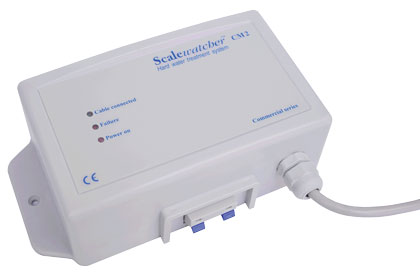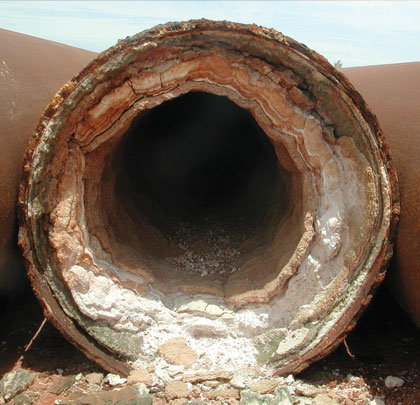Boil a kettle of water in a hard water area and two undesirable observations are made: A fine but harmless scum appears on the surface of the water and a hard white encrustation develops on the heating element. The latter is calcium carbonate and is usually referred to as limescale. The limescale that deposits on the heating element will, if untreated, reduce the efficiency of the kettle, induce corrosion of the element and ultimately lead to appliance failure. However, it is not just domestic appliances that are effected, boilers and steam generators also develop limescale deposits, which will develop similar problems if left untreated.
Limescale can form wherever water is heated. The reason for the problem is that source waters (potable or ground water) contain dissolved mineral salts, sometimes described as hardness, which have low solubility in the water. When heated, the water can no longer hold these salts in solution and deposition must then occur.
WHAT CAN GO WRONG?
Deposits are an insulting layer on heat transfer surfaces. This leads to more power being consumed or to the need to install heavier duty equipment to compensate. It is estimated that 40 percent more energy is needed to heat water in a system fouled with ¼ inch (6.35 millimeters) of limescale.
Scale in water lines reduces the available cross-section area and the throughput. Eventually the line will become completely blocked. Overheated boilers can be dangerous.
In order to establish if you have a problem try answering these questions:
- Do appliances such as water-fed equipment contain white scale?
- Are there signs of unexpected deposit formation around valves or at the pipe outlets?
- Are boilers/heat exchangers performing below design?
- Is corrosion a problem?
- Is the water throughput less than expected?
The more times that the answer is “yes,” then the more likely it is that you have scale.
ELECTRONIC WATER CONDITIONING
Electronic water treatment (EWT) is a non-invasive system utilizing a solenoid coil or coils wrapped around the pipework to be treated. A continuously frequency changing signal generator within a specified range supplies current to the coils. The pulse shaped current creates an induced electric field, concentric around the axis inside the pipe. As a consequence to this arrangement, any charged particle or ion moving within the field experiences a so-called Lorentz force generated by the interaction between charged particles and magnetic and electric fields.
The treatment influences the initial nucleation, resulting in crystals that do not “stick” together. Untreated water builds up matted structures that continuously grow. This treatment creates idiomorphic, scattered crystals, which do not form matted structures. They have a rotundas shape, which means that they have a larger volume in relation to a smaller surface. This feature makes them sensitive to water currents and they are easily flushed out of the pipeline. As no new scale layers are formed, the sheer force of the water flow will gradually remove existing layers of scale. The ability to adjust power, frequency and coil configurations of products like the Scalewatcher on site enables performance to be optimized with no downtime and no pipe replacement.
OPERATING MECHANISMS OF ELECTRONIC DEVICES
Current scientific literature describes the macro effects, which are the consequence of fundamental interactions between applied fields and precipitating substances. The amount of energy that is introduced by a solenoid coil is very small (the consumption of a household Scalewatcher unit is one order of magnitude less than a cordless telephone).
To study the induced fields, scientific tools of high precision are needed which do not interfere with the interactions that we want to measure. The atomic force microscope (AFM), capable of examining growth patterns on surfaces at the highest resolution, is a tool that can demonstrate some of the key interactions.
To understand the mechanism, some knowledge of mineral scale precipitation is necessary. We know that in order to form a scale deposit three conditions must be met;
- The solution must be supersaturated with mineral ions.
- Nucleation sites must be available at the pipe surface.
- Contact / residence time must be adequate.
To prevent scale it is necessary to remove at least one of these pre-conditions. Clearly contact time is not an alterable factor. To be effective any device must therefore affect either the super saturation value or the nucleation process. The direct effect of the electronic device described above is on the nucleation process and in particular to enhance initial nucleation through the creation of new nucleation sites within the bulk fluid flow. This is controlled precipitation. Crystal growth then occurs at these points of nucleation and not at the pipe wall. Suspended solids increase with a corresponding drop in the level of super saturation, and these effects have been observed in the field. The localized pH increase near the pipe wall caused by hydroxyl radicals formed by electromechanical interactions is one mechanism that drives the changed nucleation characteristics.

ELIMINATING SCALE BUILD-UP
As there is no more scale build-up, the flowing water will remove existing layers of scale over time. This is mainly caused by diffusion according to the law of mass action. By electromagnetic treatment with the Scalewatcher ‘hard’ water is capable of dissolving and removing existing scale layers.
EWT products, such as the patented Scalewatcher, affect the formation of scale by increasing the homogeneous precipitation rate of calcium carbonate and certain other minerals. The ability to adjust power, frequency, and coil configurations on site enables performance to be optimized with no downtime and no pipe replacement. ■
[divider]
ABOUT THE AUTHOR
Jan de Baat Doelman is the president of Scalewatcher North America Inc. The Scalewatcher is an environmentally friendly alternative to chemical and mechanical descaling. Launched in the 1980s it has successfully treated hard water problems for industrial manufacturers as well as water companies, oil producers, farmers, horticulturists, shipping companies, shopping centers, school, universities and government establishments. For more information, visit www.scalewatcher.com.
________________________________________________________________________
MODERN PUMPING TODAY, March 2014
Did you enjoy this article?
Subscribe to the FREE Digital Edition of Modern Pumping Today Magazine!
![]()


